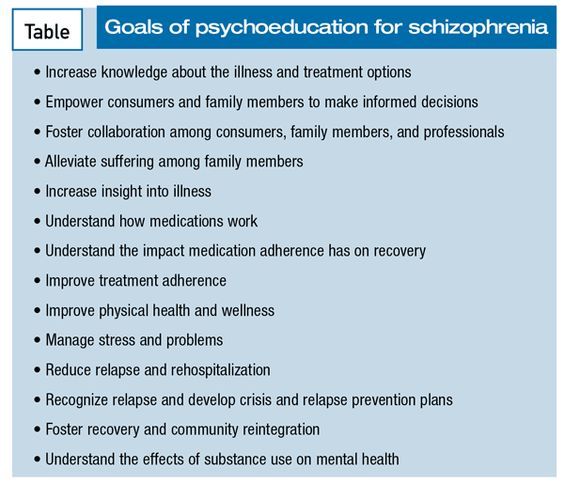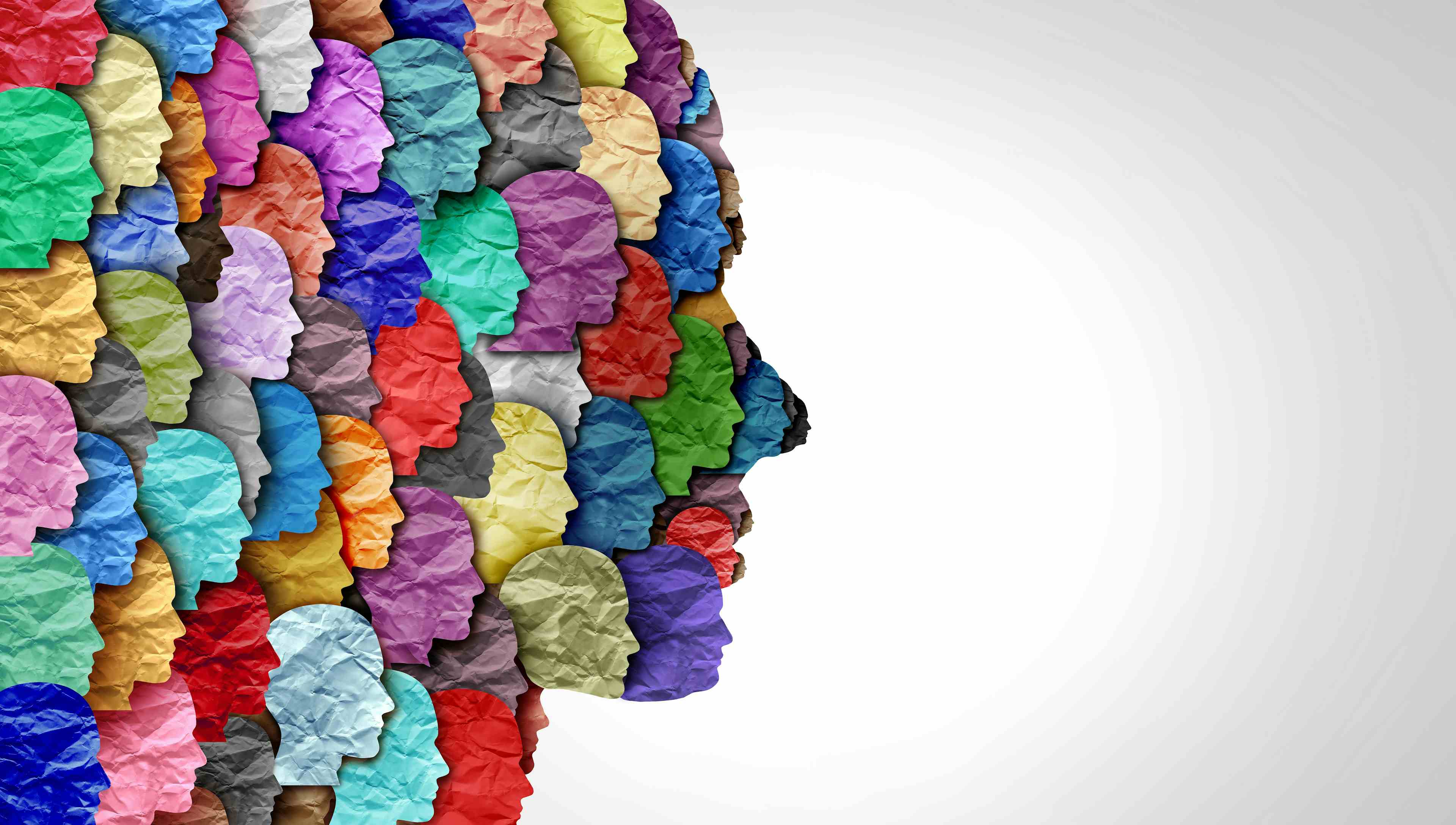Publication
Article
Psychiatric Times
An Evidence-Based Practice of Psychoeducation for Schizophrenia
Schizophrenia is often characterized by lack of insight, treatment nonadherence, and poor prognosis. However, research suggests that patients with schizophrenia benefit immensely from learning about their illness.

Health care decisions can have life-altering consequences, so consumers must be as informed as possible. This is particularly true when it comes to developing treatment programs for schizophrenia. Schizophrenia is often characterized by lack of insight, treatment nonadherence, and poor prognosis. However, research suggests that patients with schizophrenia benefit immensely from learning about their illness. The Cochrane analyses on psychoeducation for schizophrenia found that psychoeducational interventions significantly reduced relapse and readmission rates, enabled fewer hospital days, increased medication adherence, increased satisfaction with mental health services, and improved quality of life.1
According to the American Psychiatric Association (APA) treatment guidelines, psychoeducational interventions should be part of the standard therapy for patients with schizophrenia.2 The Substance Abuse and Mental Health Services Administration has identified family psychoeducation as an evidenced-based practice that should be implemented in psychiatric settings.3 And, the Schizophrenia Patient Outcomes Research Team recommends education for patients with schizophrenia and their families as well as psychosocial interventions that include psychoeducation for weight loss in overweight individuals with schizophrenia.4
Over the past decade, providers have increasingly focused less on the long-term disability associated with schizophrenia and more on recovery. In a recovery-oriented paradigm, there is an emphasis on patient involvement and a focus on facilitating a collaborative relationship by providing psychoeducation. Psychoeducation cultivates a shared decision-making approach that brings together the clinician’s expertise and the patient’s treatment preferences. Shared decision making fosters autonomy, which results in decisions that better serve the individual’s choices, values, and interests. “Shared decision making provides an approach through which providers and consumers of health care come together as collaborators in determining the course of care. Research has shown that shared decision making . . . increases consumers’ knowledge about and comfort with the health care decisions they make.”5
What is psychoeducation?
Patient and family education, ie, psychoeducation, is an evidence-based psychotherapeutic intervention for patients with mental illness and their families. It teaches patients and their families about the nature of the illness, its treatment, coping and management strategies, and skills needed to avoid relapse (Table). Psychoeducation has been defined as “the education of a person with a psychiatric disorder in subject areas that serve the goals of treatment and rehabilitation.”1
Psychoeducation includes cognitive, behavioral, and supportive therapeutic elements. Education is a gradual process, and intended outcomes of psychoeducation fall on a continuum and build on one another.
Psychoeducational approaches are intended to increase knowledge of and insight into illness and treatment. The goal of psychoeducation is behavioral change, which will lead to better treatment adherence. A psychoeducational program designed for patients with schizophrenia generally teaches participants that schizophrenia is a brain disor-der that is partially helped by medication and that other factors, including family involvement, stress, substance abuse, and coping skills, affect recovery.
Psychoeducation can be offered to patients, family members, or both. Study results from more than 30 randomized clinical trials have shown reduced relapse rates, enhanced recovery, and improved family well-being.6 Effective family psychoeducation includes empathic engagement, problem-solving and communication skills, social networking, education on clinical resources, and ongoing support.
Patients with serious mental illness, such as schizophrenia, are vulnerable to alcohol and drug abuse and may have co-occurring substance use problems. Substance use will worsen the mental health problem, and when the mental health problem goes untreated, or worsens, it makes patients more prone to addictive behaviors. Substance use may also be a risk factor for medication nonadherence. Therefore, it is important to educate patients with schizophrenia about the adverse effects of substance use.
What is already known about the role of psychoeducation on treatment adherence for patients with schizophrenia?
? Patients with schizophrenia can benefit from learning about their illness. Guidelines recommend psychoeducational interventions as part of standard treatment for patients with schizophrenia.
What new information does this article provide?
? Recovery-oriented psychoeducation can cultivate a shared decision-making approach that brings together the clinician’s expertise and the patient’s treatment preferences. Tips and strategies that can help foster recovery, wellness, and shared decision making are provided as well as a list of wellness- and recovery-oriented psychoeducational materials and resources.
What are the implications for psychiatric practice?
? Implementing recovery- and wellness-oriented psychoeducational programs and materials as part of standard treatment may improve mental and physical health outcomes in patients with schizophrenia.
Education and medication
Poor medication adherence is an overlooked but serious public health problem. “Lack of medication adherence is America’s other drug problem and leads to unnecessary disease progression, disease complications, reduced functional abilities, a lower quality of life, and even death.”7 It is estimated that only 50% of patients typically take their medications as prescribed. There is growing recognition that a multidisciplinary approach to medication-taking behavior is necessary.
The National Council on Patient Information and Education (NCPIE) recommends a “medication education team” in which the patient and all members of the health care team work together to treat the patient’s condition while recognizing the patient’s key role at the center of the process. Low health literacy and limited English proficiency are major barriers to adherence and deserve special consideration. The NCPIE recommends the following key strategies to improve medication adherence7:
• Use verbal discussion reinforced with appropriately designed written materials to help the patient understand the medical condition and the need for and value of treatment
• Provide verbal information on the proposed medication with all attendant risks and benefits
• Provide useful written information in “patient language” with details on how to administer the medication, the exact time it should be taken and why, how long to take it, common adverse effects, special precautions, and how to monitor progress
• Provide information about medication adherence aids, such as pill boxes and refill reminder programs
• Monitor patient adherence at every visit
• Provide information for patients and caregivers about ways to monitor adherence at home
According to the APA, psychiatrists should offer patients information about their condition, the proposed treatment, the benefits and risks of the proposed treatment, and available alternatives to the proposed treatment along with their benefits and risks. Likewise, the Medication and Counseling policy at the University of Medicine and Dentistry of New Jersey states that all prescribers should provide medication counseling information that includes printed medication information fact sheets.
In a recovery-oriented paradigm, medication is seen as a tool to help patients manage the illness and achieve their life goals. Using a shared decision-making approach, in which the clinician and the patient are partners who share information with each other, is important when it comes to making decisions about medication. The clinician may learn something about how the patient feels about a medication or an adverse effect that may influence selection of medication. For example, weight gain might be tolerated by a patient who is in crisis but may be less well accepted as the patient recovers.
Research findings suggest that treatment outcomes are improved when the patient understands the connection between treatment adherence and the ability to achieve personal goals.8 For example, if a patient is interested in working, a discussion of how medication reduces symptoms may be a motivating factor for adherence. Behavioral cues, such as using pill-reminder boxes and appointment calendars, can increase medication adherence.
Psychoeducation about health and wellness
Patients with serious mental illness die, on average, 25 years earlier than persons without mental illness.9,10 Preventable conditions cause much of this increased medical morbidity and mortality. The higher rate of modifiable risk factors (eg, smoking, poor nutrition, obesity, lack of physical activity, substance abuse) in persons with serious mental illness leads to a higher prevalence of cardiovascular disease, diabetes mellitus, and respiratory diseases. By reversing unhealthy behaviors, patients can improve their health status and reduce morbidity and mortality.11
Concern about excess medical morbidity and mortality has raised awareness of the importance of integrating physical health and wellness into behavioral health care. The Substance Abuse and Mental Health Services Administration launched a national wellness action plan to address this problem. In recent years, specialized psychoeducational materials have been developed or expanded that address the physical health and wellness issues of patients with mental illness.12
Putting psychoeducation into practice
Psychoeducation can be delivered across all levels of care and treatment settings (eg, inpatient, outpatient, private practice, day treatment [partial hospitalization]) to individuals or to groups. A variety of professionals and nonprofessionals, including psychiatrists, psychologists, nurses, social workers, trained family members, and peer specialists, can provide the psychoeducation.
Group or individual therapy sessions may contain a psychoeducational component. For example, as part of a medication management session, a clinician may routinely spend several minutes educating a patient about ways to cope with stress, manage adverse effects, or maintain a healthy body weight.
For group or classroom settings, the ideal group size is between 10 and 14 participants. If the group is larger, it may be helpful to have a cofacilitator. Groups can have open or closed enrollment. If group members can drop in and out of the group and new members can join, it is considered an “open” group. Once a group becomes established, it may become “closed” to new members, but it may open up again in the future. For example, an inpatient unit may chose to have an open psychoeducational group in which most patients can participate on a daily basis. However, a partial hospitalization program may choose to have a closed group on a topic such as “Getting the Best Results From Your Medication,” with the same 15 clients; the group meets 3 times a week for 4 weeks and opens up to new members once the specific topic is covered.
A typical psychoeducational group lasts an hour, takes place about 2 times a week, and generally consists of between 4 and 20 sessions. However, this format can vary greatly depending on the psychoeducational program, the needs of the participants, and the type of facility.
Psychoeducation may involve the use of manualized programs, pamphlets, educational handouts, videotapes, or a combination of these. Many psychoeducational programs and materials are available, some of which are free. Some programs can be easily implemented; others require formal training and ongoing consultation. (See “Psychoeducational Resources” for a brief list of available programs and materials.)
Delivering psychoeducational interventions is an art as well as a science. To deliver group psychoeducation, a clinician-educator or a facilitator, rather than a group leader, is suggested.12 Using multimodal techniques, the facilitator actively guides the group discussion and provides a strong educational component to each session.
Multimodal teaching techniques (eg, visual, auditory, kinesthetic) are particularly relevant because of the cognitive challenges present in schizophrenia. For example, showing session participants a model of the brain or a test tube containing the amount of sugar in a can of soda is often worth a thousand words. Handouts to share with family members can be enlightening and reinforce lessons learned.
Regardless of whether psychoeducation is delivered to individuals or groups, patients or families, important clinical skills include the ability to relate, connect, and convey hope and encouragement within a genuine context of respect and attunement to personal goals and needs. “The goal is to move beyond information toward inspiration, focusing on the process of how the knowledge is experienced by the person’s personal framework and integrated into a useful story that has personal meaning and relevance.”13
Summary
During my initial assessment of patients, I discuss individual recovery goals and how medication and other treatment can help the patient achieve his or her goals; this discussion continues throughout treatment. I ask if the patient would like a family session, and I include family psychoeducation as needed.
A variety of educational pamphlets and handouts on topics such as schizophrenia, recovery, and nutrition are readily available in my office, in the waiting rooms, and on bulletin boards. A brief physical health history is included in the initial assessment. I provide education about the higher risk of medical morbidity and mortality, and the patient and I collaborate on a prevention plan. If nicotine dependence and obesity are present, they are discussed and documented along with other physical health problems.
Asking patients to rate their interest and confidence in taking medication, quitting smoking, and losing weight on a scale of 1 to 10 can be enlightening. Use of pill-reminder boxes and appointment calendars is frequently recommended. These strategies can be used whether the provider is in private practice or is working in a clinic setting.
Recovery-oriented and physical health goals are included in the individual’s service plan. My organization maintains a Medical Providers Database with practitioners interested in treating patients with mental illness along with the insurance plans they accept, and referrals are made when needed.
Medication fact sheets are available to help guide medication counseling discussions. If the patient is receiving an atypical antipsychotic, information is provided about the weight gain potentials of the various agents, the possible metabolic effects, and the need to monitor for adverse effects. Baseline and ongoing weights are tracked. Brief nutritional and physical activity advice are offered, along with a variety of educational handouts that include a self-monitoring log for weight and other health measures. Handouts on topics such as stress management are also available. In addition, there are several wellness stations where patients can self-monitor their weight and other health measures and where there is easy access to a variety of patient educational materials.
In some communities, peer services may be available; practitioners can check with organizations such as the Division of Mental Health Services for a listing of peer-run services.
References:
1. Xia J, Merinder LB, Belgamwar MR. Psychoeducation for schizophrenia. Cochrane Database Syst Rev. 2011;(6):CD002831.
2. American Psychiatric Association. Practice Guideline for the Treatment of Patients With Schizophrenia. 2nd ed. Arlington, VA: American Psychiatric Association; 2004.
3. The Substance Abuse and Mental Health Services Administration (SAMHSA). How to Use the Evidence-Based Practices Kits: Family Psychoeducation. http://store.samhsa.gov/shin/content//SMA09-4423/HowtoUseEBPKITS-FP.pdf. Accessed November 29, 2011.
4. Kreyenbuhl J, Buchanan RW, Dickerson FB, Dixon LB; Schizophrenia Patient Outcomes Research Team (PORT). The Schizophrenia Patient Outcomes Research Team (PORT): updated treatment recommendations 2009. Schizophr Bull. 2010;36:94-103.
5. The Substance Abuse and Mental Health Services Administration (SAMHSA). Shared Decision-Making in Mental Health Care: Practice, Research, and Future Directions. 2011. http://store.samhsa.gov/shin/content//SMA09-4371/SMA09-4371.pdf. Accessed November 29, 2011.
6. McFarlane WR, Dixon L, Lukens E, Lucksted A. Family psychoeducation and schizophrenia: a review of the literature. J Marital Fam Ther. 2003;29:223-245.
7. National Council for Patient Information and Education (NCPIE). Enhancing Prescription Medication Adherence: A National Action Plan. August 2007. http://www.talkaboutrx.org/documents/enhancing_prescription_medicine_adherence.pdf. Accessed November 29, 2011.
8. Zygmunt A, Olfson M, Boyer C, Mechanic D. Interventions to improve medication adherence in schizophrenia. Am J Psychiatry. 2002;159:1653-1664.
9. Colton CW, Manderscheid RW. Congruencies in increased mortality rates, years of potential life lost, and cause of death among public mental health clients in eight states. 2006. http://www.ncbi.nlm.nih.gov/pmc/articles/PMC1563985/pdf/PCD32A42.pdf. Accessed November 29, 2011.
10. National Association of State Mental Health Program Directors (NASMHPD) Medical Directors Council. Parks J, Svendsen D, Singer P, Foti ME, eds. Morbidity and Mortality in People With Serious Mental Illness. 2006. http://nasmhpd.org/general_files/publications/med_directors_pubs/Mortality%20and%20Morbidity%20Final%20Report%208.18.08.pdf. Accessed November 29, 2011.
11. Vreeland B, Toto AM, Verna M, Williams JM. Cultivating physical health and wellness utilizing a person-centered approach. In: Rudnick A, Roe D, eds. Serious Mental Illness: Person-Centered Approaches. New York: Radcliff Publishing; 2011:284-300.
12. Williams JM, Ziedonis DM, Vreeland B, et al. A wellness approach to addressing tobacco in mental health settings: learning about healthy living. Am J Psychiatr Rehabil. 2009;12:352-369.
13. Roe D, Yanos PT. Psychoeducation for people with psychotic symptoms: moving beyond information and towards inspiration. Behav Therapist. 2006;29:53-56.






























